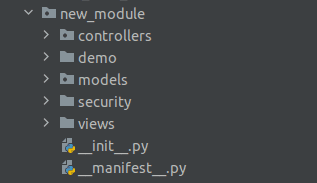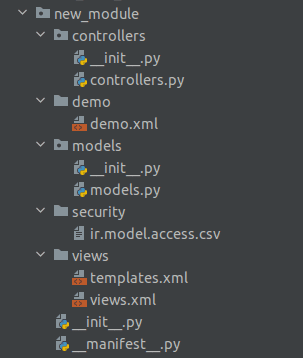Scaffold command
Scaffolding in Odoo is the process of creating a skeletal structure for a module. We can
design the module structure automatically using Odoo scaffolding. It saves us a lot of
time and works as compared to manually constructing a module. A module is usually a
directory within a module directory. Addons path specifies the module path. To begin,
you can build a new module under /opt/odoo/custom add-ons, such as custom add-ons. To
create a module structure, we must first travel to the Odoo-bin location using the
terminal.
Enter the scaffold command we can create a sample module structure. The command is
./odoo-bin scaffold module_name folder_name
module_name: Name of the module
folder_name: Name of the directory inside which you need to create the module.
In usual cases, Within a module directory, a module is a directory. Addons path specifies
the module path. To begin, create a new module in /opt/odoo/custom addons, for example,
custom addons. To create a module structure, we must first travel to the odoo-bin
location using the terminal. To automatically generate a module structure, run the
following command:
./odoo-bin scaffold new_module custom_addons
Executing the above command, create a new module with some directories.

Expanded view of the module

Each module contains required python files; they are ‘__init__.py’ and ‘__manifest__.py’
files.
Here, we can see that every directory inside the module will be generated by itself.
You can make changes to the content that is required.
1. The models are the python files contained within the module.
2. The XML files which help to display the records are views.
3. Data contains demo data that are needed in the module. It consists of XML that
creates/updates databases.
4. The security file contains the configure files of access rights.
5. __init__.py file is import all the python files defined in the module.
6. When we need to render data to the website, we use controllers. The functionality of
the models, for example, is insufficient to display the sale order data on the website.
In such circumstances, front-end modules must be integrated with the backend.
Controllers are used to configuring front-end modules, so to speak.